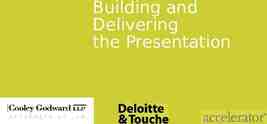THE PROCESS OF ADJUSTMENT By John McMahon, Ph. D., CVRT
23 Slides102.25 KB

THE PROCESS OF ADJUSTMENT By John McMahon, Ph. D., CVRT Email: [email protected]

SOMETHING TO THINK ABOUT To help the consumer adjust to vision loss, what is the first activity the professional should do? 1. 2. 3. 4. Get the consumer to acknowledge their vision loss. Help the consumer understand their eye condition. Build a trust relationship with the consumer. Teach the consumer a skill where they can experience immediate success.

PSYCHOSOCIAL ADJUSTMENT TO LOSS OF VISION *Historically been viewed as a process in which the individual passes through sequential stages *Culmination of this process is to come to terms with the visual impairment and to ultimately accept it as another personal attribute.

BUILDING A TRUST RELATIONSHIP IS ESSENTIAL An instructor is not simply a teacher, but a teacher with a therapeutic purpose. To be most effective, instructors must establish a person-centered, trust relationship with consumers. The quality of the therapeutic relationship that grows out of the trust relationship, as opposed to simply teaching techniques, is the primary agent of growth in the consumer. The more genuine the trust relationship, the more therapeutic it becomes. Once this relationship has grown to the point where the individual feels safe and trusting, the provision of skill instruction will flow more naturally. If the consumer feels safe, and the therapeutic relationship is strong, then the desire to change can grow within the consumer

PREMIS OF FREUD ID; the primitive part of the psyche that drives us to seek our most basic biological needs at any cost. EGO; instinctive reaction to the Id. If basic needs are not met or are threatened, the Ego reacts strongly to obtain them. SUPEREGO; Our instinctive reaction that modify the efforts of the ego to address the threat to meeting our basic biological needs. Often viewed as our conscience, ethics, or moral compass.

MASLOW’S HIERARCHY OF NEEDS *Maslow believed that human motivation stems from our need to reach the next and subsequent levels of the hierarchy. 8 Transcendence Beyond self, care for others and nature. 7 Self-actualization To reach one’s potential, to do good 6 Aesthetic Beauty 5 Cognitive To know 4 Esteem Self-respect, respect from others 3 Social Love, belonging 2 Safety Shelter, laws 1 Biological/physiological Food, drink

CREATION OF PSYCHOLOGICAL DEFENSE MECHANISMS Reactions to threats have a conscious a subconscious component Subconscious reacts automatically to decrease the trauma associated with not meeting basic needs. Behaviors stemming from the conscious are logical and rational. Behaviors stemming from the subconscious are irrational and abnormal. They are not logical. They can appear to be nonsensical, counter-productive, and even threatening.

USE OF PSYCHOLOGICAL DEFENSE MECHANISMS Psychological defense mechanisms are healing tools that naturally occur in humans and that protect us from the trauma posed by sudden, unexpected, and massively extensive event, such as the death of a loved one; break up of a marriage, or the onset of vision loss. Another way to look at a psychological defense mechanism is as a subconscious protective reaction to an unacceptable reality. Important to remember that psychological defense mechanisms function like our autonomic nervous system; they are automatically triggered.

IMPORTANCE OF IDENTIFYING PSYCHOLOGICAL DEFENSE MECHANISMS Having a basic knowledge of psychological defense mechanisms is essential to vision professionals primarily because mistakenly interpreting them as a consumer’s personal characteristics can cause us to dislike or react negatively to the individual. Confronting psychological defense mechanisms can quickly undermine the trust/therapeutic consumer relationship. Psychological defense mechanisms enable a teacher or counselor to measure adjustment and determine the best therapeutic approach. The use of psychological defense mechanisms becomes inappropriate when an individual rigidly or continuously clings to its use.

PSYCHOLOGICAL DEFENSE MECHANISMS COMMON EARLY IN ADJUSTMENT PROCESS They come and go during process of adjustment, strong ones being common early and less severe forms being used later in the process. Early psychological defense mechanisms may include: - Denial, characterized by subconsciously ignoring the very fact that a problem exists or that it will be permanent. - Withdrawal, characterized by subconsciously decreasing the need for human interaction and by pulling away. - Regression, characterized by subconsciously going back in life to a safer time or place. - Intellectualization, subconsciously avoiding intolerable feelings through abstract and precise thinking.

PSYCHOLOGICAL DEFENSE MECHANISM CAN BE POSITIVE OR NEGATIVE Positive when using them to adjust to the onset of a significant life event, such as vision loss, but negative if continually used to protect a poor self-image. The loss of sight is a serious blow to one’s self-image and self-esteem; the individual's feelings of self-worth, ability, and significance. Individual's level of self-image and self-esteem, is determined both by internal and external factors. Internal factors; perception of success, defenses, values, and aspirations. External factors; how others react to an individual’s behavior. New vision loss, which usually makes even the simplest daily tasks seem difficult or impossible, causes devaluation of the “self,” which is commonly reinforced by the pity of people around them.

HISTORICAL THEORIES OF ADJUSTMENT Acceptance of vision loss has to occur before instruction is accepted. Rehabilitation instruction is better approached after one’s self-esteem has been totally reorganized and client have accepted the loss. Use of instruction to promote acceptance. Inexperienced blindness professional need to be aware that one of the skills they need is the ability to engage consumers under such conditions, because ignoring them in such a situation will prolong inaction and delay acceptance.

LIVNEH’S UNIFIED MODEL OF ADJUSTMENT This comprehensive model theorizes that the adjustment process can be explained in five overlapping stages. This model suggests that the stages can be identified by observing the client to determine which psychological defense mechanisms they use and what emotions and actions they display. Stages are not discrete, instead, they overlap, blend, can be skipped over, and may last hours, days, months, or become permanent. Dynamic movement through the stages indicates psychosocial growth and the endpoint is the replacement of psychological defense mechanisms by adaptation or logical coping. Movement from one stage to the next should not be based on a single sentence or two, but identify a consistent pattern of actions and statements.

LIVNEH’S STAGES OF ADJUSTMENT Stage 1 Initial Impact. Often not observed by blindness professionals as people in this stage generally avoid interactions with others. Signs are obvious as people early in this stage enter a kind of trance characterized by numbness and inactivity and then progress to a sub stage of great anxiety and agitation. Psychological defense mechanisms are not yet operative.

LIVNEH’S STAGES OF ADJUSTMENT Stage 2 Defense Mobilization. Will recognize by language, behaviors and emotions associated with denial. Termed the “I don’t need.” Clients will often talk about a cure, operation, or hope that vision will get better. Professional can often mistake the hopefulness and apparent happiness with adjustment. These reactions and statements are common and the consumer sincerely believes they are true, so the professional is faced with a dilemma: How do I get this individual to participate, force him by telling him that he really is blind or work around this problem by trying to get him interested in learning something that is dear to him and that he is currently unable to do?” Repression-weaker form of denial. Enables individuals to push the problem to the background. Intellectualization- avoiding intolerable feelings through abstract and precise language.

LIVNEH’S STAGES OF ADJUSTMENT Stage 3 Initial Realization. Movement from Denial to the Initial Realization Stage is dramatic, the hopefulness of denial ceases and sadness and hopelessness become unavoidable and painfully apparent. Termed the “I can’t” stage. Professional is faced with another kind of reluctance, one based on the belief that nothing can help. Often hear statements like, “How do you expect me to learn this stuff, I can’t see anything.” I can’t read and reading by listening to people read isn’t really reading; What do you mean , “use the stovetop, I can’t even tell the stove from the counter topI can’t do it, but that is okay because my husband will do it for me! Professionals often must continue to try until a lesson is accepted. Regression- movement back to a safer time or place. Withdrawal-decreasing one’s need for interaction. Initial Realization is sometimes followed by a sub stage, termed, Internalized anger. Internal anger can lead to self-blaming and guilt, and in some cases, to suicidal thoughts.

LIVNEH’S STAGES OF ADJUSTMENT Stage 4 Retaliation/Rebellion. Characterized by outwardly focused anger and hostility. Termed, the “I won’t Stage.” Statements like “I won’t do it that way, when I reached to 9:00 like you told me to, I spilled my coffee! I thought you were a professional, but you don’t even know your clock positions yourself!” Blindness professionals can defuse the situation by simply apologizing and working into the next lesson. Projection, a PDM characterized by individuals subconsciously ascribing their undesirable feelings, thoughts onto others. Avoiding confrontations will preserve the therapeutic relationship and foster cooperation.

LIVNEH’S STAGES OF ADJUSTMENT Stage 5 Reintegration or Reorganization. People acknowledge the permanence and future implications of the loss of vision. They recognize their changed self-image. Termed the, “I will” or “I can” stage. Easily identified by individuals’ increasingly positive attitude, willingness and eagerness to learn, and becoming a partner in their rehabilitation. Substitution- willingness to accept adaptive and alternative techniques. Compensation-accepting alternative methods and goals.

SIGNIFICANT MISCONCEPTIONS AND LACK OF KNOWLEDGE ABOUT BLINDNESS CAN LEAD TO PREJUDICE Simply put, prejudice is a function of a belief or attitude and is not a result of fact, but of illogical beliefs stemming from a person without vision impairment use of psychological defense mechanisms. Prejudice has numerous sources that are common in everyday occurrence. It is difficult for people who are not blind or visually impaired to understand the widespread nature and of prejudice and discrimination related to vision impairment.

OVERCOMING PREJUDICE RELATED TO VISION LOSS The reality of society’s prejudice poses areal barrier that people with vision impairment must overcome in order to effectively return to everyday life. Prejudice can be especially difficult for those just starting and those nearing completion of the adjustment process. When persons newly experiencing blindness or vision impairment first begin the adjustment process, they still have their own prejudices about blindness and they view themselves from that perspective, which can lead them to becoming victims of their own prejudices and narrow views. Prejudice commonly occurs when clients leave the protective teaching environment with an instructor, and begin returning to involvement in their communities and begin to face every day prejudice. Even though society’s prejudices are a part of the social landscape, they are significantly more limiting than is our consumer’s blindness.

OUR ROLE IN MINIMIZING OR OVERCOMING PREJUDICE RELATED TO BLINDNESS Teaching functional skills and providing emotional support promote adjustment. -competence minimizes effect of prejudice. -teaching of self-advocacy skills. The instructor’s efforts won’t directly solve the prejudice problem, but they can lessen its effect by educating their clients on its presence before closing their service. -Educating clients on the type of prejudice related to vision impairment they might commonly encounter. -Use of humor is a powerful tool. -Introduce topic in everyday conversations during lessons. People hold their prejudices in their subconscious and are not aware of them. Consequently, educating people without vision impairment cannot be effectual, since we assume everyone except us is prejudiced.

IMPACT ON THE FAMILY Spouses of individuals with acquired vision loss and parents of children with visual impairments are highly affected by a family member’s vision loss. Like the person newly experiencing vision loss, they have experienced a sudden, unexpected, and massively extensive event, the loss of their future hopes and dreams. Therefore, they also, like someone newly blinded, will experience the stages of Livneh’s model as they adjust to their new life situation. Both marriage partners are simultaneously employing psychological defense mechanisms. Parents of newborns employ psychological defense mechanisms.

Reference List Carroll, T. J. (1961). Blindness: What it is, what it does, and how to live with it. Boston: Little Clark, A.J. (1991). The identification and modification of defense mechanisms in counseling. Journal of Counseling & Development, 69, 231-236. Dodds, A. G., Bailey, P., Pearson, A., & Yates, L. (1991). Psychological factors in acquired visual impairment: The development of a scale of adjustment. Journal of Visual Impairment & Blindness, 85, 306Ð310. Lieberman, L., Ponchillia, P. E., & Ponchillia, S. (2013). Physical education and sports for people whith visual impairments or deafblindness: Foundations of instructions. AFB Press. New York. Livneh, H. (1991). A unified approach to existing models of adaptation to disability: A model of adaptation. In Marinelli, R. P., and Dell Orto, A. E. (eds.), The Psychological and Social Impact of Disability, 3rd ed., Livneh, H. (1986) A Unified Approach to Existing Models of Adaptation to Disability: Part 1: A Model of Adaptation. Journal of Applied Rehabilitation Counseling, 17, 5-16. Ponchillia, P. E. & Mc Mahon, J. M. (2020). Psychosocial Considerations (Chapter 2) Within Foundations of Vision Rehabilitation Therapy. APH Press, Louisville, Kentucky. Ponchillia, P. E. & Ponchillia, S. V., (1996). Foundations of Rehabilitation Teaching for people Who are Blind or Have Low Vision. New York: AFB Press. Rogers, C., (1961). On becoming a person: A therapist's view of psychotherapy. London: Constable. Los Angeles: Muse-Ed. Smart, J. (2016). Disability, society, and the individual–Third Edition. PRO-ED Inc. Tuttle, D.W. (1984). Self-esteem and adjusting with blindness: The process of responding to life’s demands. Springfield, IL: Thomas.






